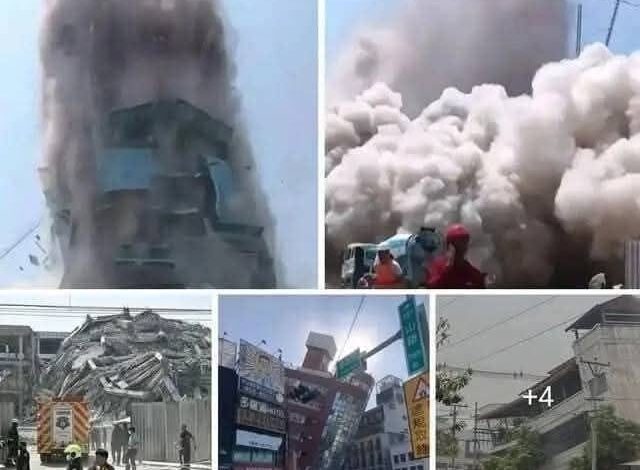
Earthquake of large magnitude leaves the city in pieces!
A massive earthquake shook the Alaskan Peninsula late Wednesday night, sending shockwaves across the Pacific and sparking widespread concern. The quake registered at a staggering magnitude of 8.2, making it one of the most powerful to hit the region in decades. The U.S. Geological Survey (USGS) confirmed that the epicenter was located about 91 kilometers east-southeast of Perryville, Alaska, at a depth of 35 kilometers.
The initial tremor, which struck with terrifying force, was followed by a series of aftershocks—at least eight in total, two of them measuring above magnitude 6.0. For residents living in the region, the night was filled with fear, uncertainty, and the blaring sound of tsunami sirens warning of a possible catastrophe.
In coastal communities like Kodiak, the warnings were taken seriously. Videos shared by Reuters showed sirens echoing through the streets as residents evacuated low-lying areas and sought higher ground. Families bundled into cars, grabbing what little they could, while others headed on foot toward designated safe zones. The atmosphere was tense, but orderly, as years of earthquake drills and preparedness efforts came into play.
The U.S. National Tsunami Warning Center (NTWC) quickly issued alerts for southern Alaska and coastal areas stretching from Hinchinbrook Entrance to Unimak Pass. These warnings set off a chain reaction of heightened monitoring across the Pacific, with agencies in Hawaii, Guam, Japan, and New Zealand closely tracking the seismic event to assess whether their coastlines were at risk.
For a brief but frightening window of time, Hawaii and Guam were under watch. Residents braced for the possibility of massive waves arriving hours later. Fortunately, after detailed analysis, both regions were declared safe as no significant tsunami threat materialized. Still, the false alarm underscored the unpredictability of seismic activity in the Pacific Ring of Fire, a region notorious for its tectonic volatility.
Alaska Governor Mike Dunleavy addressed the situation promptly, confirming the activation of the state’s emergency operations center. His administration assured citizens that all state resources were on standby, ready to respond to any reports of damage, casualties, or infrastructure failures. “The safety of Alaskans is our top priority,” Dunleavy said, urging residents to remain vigilant as aftershocks continued to ripple through the region.
International response was swift. The Pacific Tsunami Warning Center coordinated with other national agencies to share data in real time. Japan, which has endured its own catastrophic quakes and tsunamis, initiated assessments along its eastern coastline. In New Zealand, officials worked through the night, monitoring oceanic wave patterns for any signs of abnormal activity. The cooperation highlighted the global nature of seismic threats—what happens in one part of the Pacific can have consequences thousands of miles away.
While no immediate casualties or major damage were reported, the quake served as a stark reminder of the constant risks faced by those living along the Alaskan Peninsula. This stretch of land is part of the Aleutian Subduction Zone, where the Pacific Plate dives beneath the North American Plate. The geological pressure built up in this zone makes it one of the most seismically active regions on Earth, and experts have long warned of the potential for massive quakes and tsunamis.
Residents shared stories of the terrifying moments when the ground shook. Some described objects toppling from shelves, windows rattling violently, and pets cowering in fear. Others said they had grown so accustomed to smaller tremors that they initially brushed it off—until the shaking intensified beyond anything they had experienced before.
The sense of relief after learning there was no widespread destruction was palpable, but seismologists warned against complacency. “This event is a reminder that Alaska is earthquake country,” said one USGS expert. “Preparedness saves lives. Having evacuation plans, emergency kits, and awareness of tsunami routes can make all the difference in moments like these.”
For now, life in the affected towns is cautiously returning to normal. Emergency crews are conducting structural checks on bridges, schools, and hospitals to ensure their safety. Local businesses, many of which temporarily closed during the warnings, are reopening. Families who fled to higher ground have returned home, grateful that their houses remain standing. Yet the psychological impact will linger. Every creak of the earth, every aftershock, reminds residents of the fragility of their safety.
Globally, the quake reignited conversations about preparedness for “the big one”—a massive seismic event long predicted by geologists for the Pacific Northwest and beyond. Governments in earthquake-prone nations are once again reviewing safety protocols, infrastructure resilience, and public awareness campaigns.
The Alaskan Peninsula quake may not have caused widespread devastation this time, but it served as a dramatic wake-up call. It revealed both the strengths of preparedness systems—quick warnings, organized evacuations, international coordination—and the ever-present vulnerabilities of life in seismic zones. For those who lived through it, the memory of that night, the wailing sirens, and the uncertainty of whether a tsunami was on its way will not soon be forgotten.
What happened in Alaska is more than just a geological event. It is a human story of fear, resilience, and the delicate balance between living in a beautiful but unpredictable part of the world. And as aftershocks continue to rumble, one truth stands out: the earth may be unpredictable, but human determination to adapt and survive remains steadfast.




